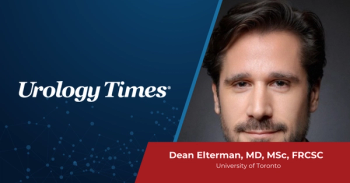
Dr. Triner on treatment of node-positive prostate cancer after RP
"We found that approximately 2 out of every 3 patients with node-positive disease go on to some form of secondary treatment within 12 months," says Daniel A. Triner, MD, PhD.
In this video, Daniel A. Triner, MD, PhD, shares the background and notable findings from the recent Urologic Oncology study “Variation in management of lymph node positive prostate cancer after radical prostatectomy within a statewide quality improvement consortium.” Triner is a urology resident at the University of Michigan in Ann Arbor.
Transcription:
Please describe the background for this paper.
The impetus for this study really came out of thinking about our own patients who we were seeing in our clinics who had positive lymph nodes at the time of radical prostatectomy, and some of the challenges they present with regards to post-surgical monitoring and indications for secondary treatment. Now, in this particular space, there's only been 1 randomized clinical trial; it's several decades old: ECOG 3886, which most people will know as the Messing trial, in which patients with node-positive prostate cancer at the time of radical prostatectomy, randomized either to observation or to immediate and lifelong androgen deprivation therapy. This group found that those patients randomized to immediate lifelong ADT had a significant overall and cancer-specific survival benefit. And on top of that, there have been a few more recent studies that have suggested that the addition of radiation therapy may also improve long-term oncologic outcomes for these patients. But we know that lymph node-positive disease is heterogeneous and a subset of these patients may never require any additional treatment. And currently, the AUA guidelines suggest for patients with node-positive disease and an undetectable post prostatectomy PSA, that both initial observation or adjuvant therapy are appropriate. At the time we were thinking about this, there really wasn't a lot of data on how these patients are being managed. And so the ultimate question we wanted to address is how patients with node-positive disease at the time of radical prostatectomy are being managed in real-world clinical practices.
What were some of the notable findings? Were any of them surprising to you and your coauthors?
We turned to the Michigan Urological Surgery Improvement Collaborative or MUSIC, and we identified greater than 600 patients who had node-positive prostate cancer at the time of prostatectomy between 2012 and 2023. A couple notable findings from the study. First, we found that approximately 2 out of every 3 patients with node-positive disease go on to some form of secondary treatment within 12 months. And interestingly, there was some level of heterogeneity in the treatment modality that these patients received. Those are large subset of patients who received immediate ADT alone within 60 days after prostatectomy, which we think is likely providers strictly adhering to the data from the Messing trial. But if we look greater than 60 days after prostatectomy, there's a split, where approximately 1 out of 3 patients received androgen deprivation alone, 1 out of 3 patients received radiation therapy alone, and 1 out of 3 patients received some combination of the 2. Perhaps somewhat unsurprisingly, we found that a detectable PSA after prostatectomy as well as other high-risk pathological features such as higher Gleason grade group and positive surgical margins, were also highly associated with receiving some form of secondary treatment within 12 months. One concerning finding from this study, though, was that 20% of patients who had a detectable PSA after prostatectomy did not receive any additional therapy at 12 months in MUSIC. And we actually looked further out to 24 months and there was still a subset of patients who had a detectable PSA who had not received any form of secondary therapy. We know from several prior studies that this group is at particularly high risk for disease progression and development of distant metastases. Additionally, we found that even within the state of Michigan, there is wide variability and rates of secondary treatment among practices, which ranged anywhere from 28% to as high as 79%. And interestingly, if we look at the specific practice types, academic practices were highly associated with higher secondary treatment rates within 12 months and for us, this really highlighted the heterogeneity and lack of consensus on this question.
This transcription was edited for clarity.
Newsletter
Stay current with the latest urology news and practice-changing insights — sign up now for the essential updates every urologist needs.



















